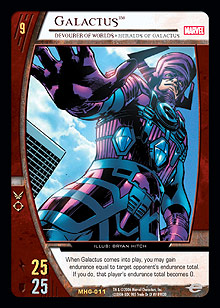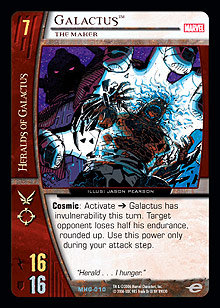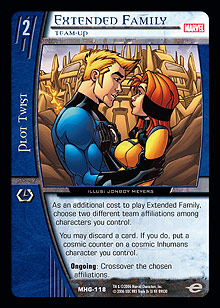
To me, one of the most interesting things about superheroes is just how diverse they’ve become in recent years. Name a power and choose a tragic beginning, and someone can likely tell you a superhero with that backstory. Much like its comic book counterpart, each Vs. System set ushers in a new mechanic or mechanics. And sometimes, it ushers in a new lead designer, as well. Heralds of Galactus was such an expansion. It was my first full lead design, and the expectation surrounding the set combined with the stigma of past cosmic sets made it quite clear it wasn’t going to be like designing a starter deck. (For people keeping score at home, I have two lead design credits to my name before this set: The X-Men and Fantastic Four starter decks.) So, it was partly as a rebellion against my starter deck design philosophy and partly out of the desire to capture the Marvel cosmic universe completely that I decided upon the design of the set.
Return of the Big Guys
 While it may not be immediately apparent, each mechanic and team was carefully designed with Galactus as a central figure. No other expansion has been designed with a single being dictating so much of the design direction; while Dr. Doom has his Reign of Terror and Mystical Paralysis, entire mechanics and teams were designed, evaluated, kept, or cut based on how they helped to define Galactus. Galactus is a world-changing cosmic being, certainly one of the most influential “big dudes” in comics if not the most powerful.
While it may not be immediately apparent, each mechanic and team was carefully designed with Galactus as a central figure. No other expansion has been designed with a single being dictating so much of the design direction; while Dr. Doom has his Reign of Terror and Mystical Paralysis, entire mechanics and teams were designed, evaluated, kept, or cut based on how they helped to define Galactus. Galactus is a world-changing cosmic being, certainly one of the most influential “big dudes” in comics if not the most powerful.
Ultimately, it was Galactus that made Heralds of Galactus the most mechanic-heavy set to date. Each mechanic defines Galactus either by describing his power, the little guys that try to fight him, or the Earth-shaking things that can happen when he’s around.
Tracing the history of the mechanics in Heralds, one can find remnants of old Galacti if you know where to look. At least half a dozen versions of Galactus interacted with the resource row or had a global effect that could wipe a board, no matter how many press characters had come into play that turn.
The development half of R&D also heavily influenced the design of Heralds. Without getting too much into the design process of Galactus himself, it was clear that if high-cost characters were going to make a return in Heralds, then the game needed to slow down. As previous sets had promoted the power levels of off-curve decks and generally decreased the quality of off-curve answers, the design team was prompted with a simple question: “In what way could Heralds slow the game down?” And, as a corollary, “How can we make games go to later turns without making games take too much time?” Heralds attempted to answer these questions in a variety of ways, one of the biggest of which was designing teams that tended to play on-curve. The lower the number of characters on the table would lead to less time spent in formation and combat. For off-curve strategies, the play pattern was also simplified. Planning future press turns is relatively easy with practice, and formation with Army characters is about as simple as it gets for off-curve decks.
Threat Diversity
 Despite an overall push to promote curve decks and decks that want to go to late turns, Heralds of Galactus still has its share of fast, aggressive, and off-curve decks. This exemplifies one of the overall goals of Heralds: to provide something for everyone. Even though R&D wanted to push the game in a certain direction developmentally, the presence of off-curve and aggressive decks in the set made a lot of sense. For the sake of balance, thematics, and to serve as a control, there are off-curve teams as well as on-curve teams in Heralds. Thematically, Galactus doesn’t spend too much time fighting other cosmic beings; mostly he’s ripping a planet out from under some poor alien race that can’t possibly fight back. It’s easier to understand the sheer magnitude and power of Galactus when it’s framed in a set that still has normal characters than if he were lost in a sea of 8-cost characters. From the smallest Moloid all the way up to Galactus himself, Heralds has cards representing every power range.
Despite an overall push to promote curve decks and decks that want to go to late turns, Heralds of Galactus still has its share of fast, aggressive, and off-curve decks. This exemplifies one of the overall goals of Heralds: to provide something for everyone. Even though R&D wanted to push the game in a certain direction developmentally, the presence of off-curve and aggressive decks in the set made a lot of sense. For the sake of balance, thematics, and to serve as a control, there are off-curve teams as well as on-curve teams in Heralds. Thematically, Galactus doesn’t spend too much time fighting other cosmic beings; mostly he’s ripping a planet out from under some poor alien race that can’t possibly fight back. It’s easier to understand the sheer magnitude and power of Galactus when it’s framed in a set that still has normal characters than if he were lost in a sea of 8-cost characters. From the smallest Moloid all the way up to Galactus himself, Heralds has cards representing every power range.
The desire to have a diversity of play patterns created an initial set structure very similar to the Origin sets; each team functions extremely differently and has powerful cards that hinge on their core identity. There is Galactus himself and his suite of plot twist effects for Heralds of Galactus, press characters for Kree, terraform locations and the Terrigenesis for Inhumans, and the unending armies of Doom robots for Dr. Doom.
Consistency without Complexity
Each Vs. set needs to answer the question of consistency. The game depends heavily on search effects to provide players with the cards they need each turn. However, searching also takes a long time and can increase the overall complexity of the game, not to mention the development problems that can arise once there is a high density of them. Frequently, new mechanics and themes will look to preserve the consistency of gameplay without flooding the set with search effects. Mechanics like boost, reservist, and terraform all subtlely increase the consistency of your deck while being invisible most of the time. One of the positives of off-curve decks is their inherent consistency; when provided with good card flow, off-curve decks can easily spend all of their resource points in one way or another each turn.
However, off-curve decks aren’t the only decks that can recruit multiple characters in a turn. Even the curve decks like Heralds of Galactus were designed to play more characters than was necessary to hit their drops each turn. This was a conscious effort to increase the character count in decks.* Increasing the character count naturally tends to be the exact opposite of what players do to improve their decks, but a greater number of characters increases the variance of play, giving players more recruiting options in-game. But as players rely more and more on the “A” squad of characters and search effects, they restrict the number of characters they play and create a more scripted experience for themselves. This may make the decks they play better, but ultimately it probably isn’t as much fun. One of the goals for Heralds of Galactus was to increase consistency without relying on search effects. So, while you will still find search effects in the set (and some good ones, at that), many teams have alternative means of being consistent, whether it be off-curve, good card drawing effects, or press.
Teaming-Up and Forgotten Legacy
 One of the biggest bummers for fans of Marvel sets was the lack of dual-affiliated characters. In Heralds, dual-affiliated characters and Team-Ups abound. As the first Marvel space set, there were literally hundreds of characters fighting to get in. This, combined with the normal pressure to provide legacy and dual-affiliated characters, served up a healthy helping of legacy-affiliated characters and allowed the teams to blend more. When Galactus arrives, everyone teams-up against him.
One of the biggest bummers for fans of Marvel sets was the lack of dual-affiliated characters. In Heralds, dual-affiliated characters and Team-Ups abound. As the first Marvel space set, there were literally hundreds of characters fighting to get in. This, combined with the normal pressure to provide legacy and dual-affiliated characters, served up a healthy helping of legacy-affiliated characters and allowed the teams to blend more. When Galactus arrives, everyone teams-up against him.
The Series
Although absent today, my constant partner in crime Billy Zonos will be contributing to future design articles. Billy’s contribution to the set was not in card design or balance, but by no means was it less significant. Billy built the initial creative vision for the set, including the choice of teams, characters, and objects that ultimately appeared. Each article will feature Billy’s perspective on the team and its flavor, while I will talk about the design and matching it to the creative vision.
See you again soon!
* Inhumans were an exception to this, as they were designed to care about hitting locations more than characters.